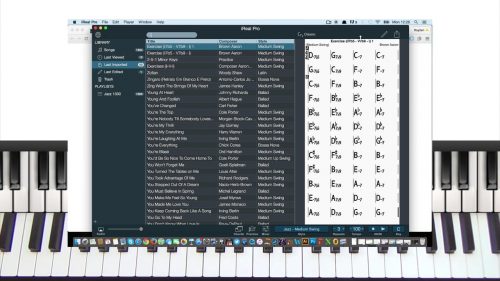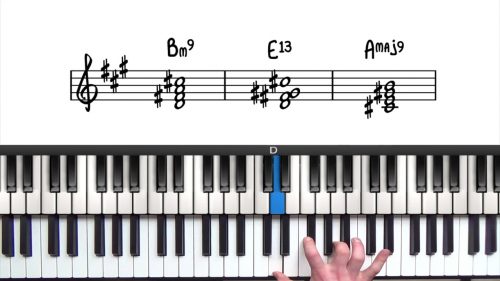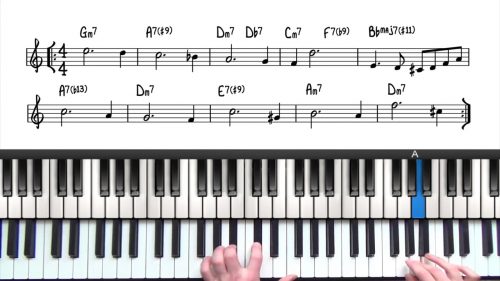Body & Soul Jazz Piano Tutorial Part 1
Body & Soul is widely quoted as the most popular jazz standard and is one of the most played ballad in the jazz repertoire. The catchy melodic motives, complex chord progressions and unusual key changes make this tune a favourite amongst jazz musicians.
Body & Soul follows a 32 measure AABA form and is written in the key of Db major however it modulates to D major and then C major in the bridge.
In part 1 we explore the form with left hand voicings. This is an important step to become familiar with the harmony. There are lot of key changes in Body & Soul and so spending the time to apply the left hand voicings with give you a clear understanding of the harmonic movement in the tune.
In part 2 of the tutorial we create a full solo piano arrangement incorporating extended and altered harmony.
Practice Tips
-
When playing through with left hand voicings, pay attention to good voice leading between the chords.
-
The idea is to keep your hand movement to a minimum which will create smoother chord transitions and modulations.
-
Left hand voicings are a great choice of voicing to support your right hand soloing and so taking the time to memorise them will help you enormously when you come to take a solo.





Hi Hayden! The score on the website is incomplete in the middle part. Just to let you know. Thanks for the lesson 😉
Thanks Michele, I’ll fix this shortly 🙂
Hayden : is still incomplete the score !
Hi Anthony,
I have updated the score.
I’ve also added a full transcription of the arrangement.
Cheers!
Hayden
Hello Hayden, just curious since I solved this ‘problem’ for myself. Namely, in bar #18 in Chord Changes above there is a F#m7 with a straight D in melody that sounds to me a bit jarring especially since it is played slowly and stands out. In the same bar in the transcript, the equivalent chord is D6/9 which sounds better to me. In the fakebook I have the chord is D/F# which can be played as D6/9 or a variation of it.
Here is the question: where did F#m7 come from and what’s the theory behind it? As I said, I am playing a variation of D chord in the bar (leading to Gm7) but am curious to learn relevant theory. Thanks, Smole
Hello Hayden: after having time on the lesson on slashed chords, I came up with an answer to my question: I am treating this F#m7 chord as a D chord over F#. Hope I am not too far off on this. As I said, I solved this problem to my satisfaction in how I play this bar/measure so no need to respond. [Don’t worry, I’m bound to have other questions on other threads]. Best, Smole
Hey Smole,
Great question.
Yes that’s exactly right…the 6/9 voicing is always a nice choice of voicing when the root is in the melody over a major chord. This is because the major 7th and root are just a half step apart, and so having both of these notes in the voicing can create dissonance.
Playing the 6th instead of the 7th removes this half step dissonance. That’s a nice rule to remember.
The F#-7 can also be viewed as a rootless Dmaj7 (3-5-7-9) and so we could look at that whole section as Dmaj7 with the E-7 chord in between to add some additional harmonic interest.
So yes I would simply look at that chord as a variation of Dmaj7. As you correctly point out, some fakebooks will show it as Dmaj7/F#.
Playing the chord as Dmaj7/F# also creates an ascending bassline. If we look at the bass notes of the chords, we have D, then E, then F#, then G, and so the bass line is climbing up the first 4 notes of the D major Scale.
Often slash notation is used to indicate a specific bass line movement. Perhaps it could be nice to play around with that too and see what kind of sound it creates.
Cheers,
Hayden
Thanks, Hayden, even though I thing I did “get it” by conceptualizing the chord as a slash chord your answer provides so much more useful info (6th instead of 7h dissonance; viewing F#-7 differently, the moving bassline) so this really clarifies things for me. Thanks again, Smole
Hey Hayden,
Just wanted to ask if this is the right way for learning these pieces. I’ve attached a document with some notes I take for lead sheets. What I’m doing here is marking up the sections with different voicings per your instruction in the video. After I mark it up with the voicings, I’ll play them till I can get them right, and then move on to a https://www.pianogroove.com/jazz-piano-lessons/body-soul-part-2/
Hi Dokko 👋
Good question!
I think this is a brilliant way to approach the task.
The end goal is for all of those numbers to be in your head, ie. when you see the chord symbol Ebm7, and you want to play a rootless voicing, you should instantly think 3-5-7-9 and then be able to ‘see’ or ‘visualise’ those notes on the keyboard as Gb-Bb-Db-F.
After learning I’d say 20 or 30 jazz standards, this process will become almost subconscious for you. It really is a numbers game with learning to play from lead sheets, the more we learn, the easier it becomes.
For me, my eyes read the chord symbol on the lead sheet, and then my hands will instantly gravitate towards certain voicing shapes. The ‘muscle memory’ in my hands just takes over. This comes with time.
It seems like what you are doing is a ‘half way step’ there. I have worked with other students that I have seen do similar approaches by writing note names above the chord. In my opinion, your approach is much better by writing the scale degrees, because those numeric formulas can be applied to any chord. Whereas the note names only apply to chord in question, if that makes sense.
If writing it down like this is helping you to visualise and find those voicings, then stick with it.
Moving on, yes I do agree that it would be difficult to notate everything like that for the more advanced arrangements, and also very time consuming.
My biggest recommendation Dokko would be to continue learning new tunes. Move onto part 2 of this tutorial to start. “Body & Soul” is a challenging tune by the way…. The harmony moves through many keys, and so it’s challenging, but good practice for us!
The main point of this lesson was to demonstrate how little the left hand moves when playing rootless voicings. Whatever the underlying harmony, type A and type B rootless voicings are all so close together and it’s almost effortless to move between them once we can visualise them.
To summarise, here’s my tips for you:
– Set the goal of playing 30 jazz standards.
– You will forget some of the old arrangements whilst learning new ones, that very natural so don’t be disheartened by that.
– Once you reach around 20, you will start to see many similarities between them, and this will make the job easier for learning new tunes and remembering the old ones!
– Another important point Dokko is memorising the form of the tune. This tune follows an AABA form, and so almost 75% of the tune is identical in terms of the chords, melody, and harmony. So once we have memorised the first 8 bars (the A Section) we actually know 75% of the tune!! Use that to your advantage.
– Check out this lesson for more information: https://www.pianogroove.com/jazz-piano-lessons/common-jazz-forms/
Learning jazz harmony is gradual process Dokko. For myself, the key was to expose myself to lots of different tunes and gradually it all comes together.
Perhaps also get started on Altered Harmony and the jazz standards in that course: https://www.pianogroove.com/jazz-piano-lessons/altered-harmony-upper-structure-triads/
I hope this helps and any further questions let me know.
Cheers,
Hayden
Thank you! So I’ll do the following for learning the standards:
– Continue to mark up the lead sheets for part 1 of pieces
– For the part 2, I’ll follow the full arrangement via the score
Hi Hayden,
Can you please explain how you construct and make sense of the chord Gb7 in the 3rd bar? I am quite confused about figuring it out.
Thank you Best, Timothy
Hi Timothy 👋🏻
Are you referring to the rootless voicing?
I understand that rootless voicings can sometimes be tricky to visualise for dominant chords!
The voicing I play is E-Ab-Bb-Eb, if we analyse those notes in terms of Gb7, I am playing the b7-9-3-13 which is a common rootless voicing for dominant chords.
It can be useful to play that voicing in your right hand, and then play the root of the chord in your left hand. That way you can analyse the notes in relation to the Gb in your left hand.
In jazz, we do not have the play the root in our voicings, and this allows us to access lots of different textures over a single chord type. In part 2 of this tutorial we add some bigger 2-handed voicings which sound great too – variety is the key!
Let me know if the above helps and any further questions just let me know.
Cheers, Hayden